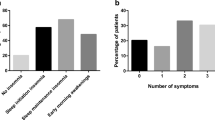Abstract
Obstructive sleep apnea (OSA) and insomnia are among the most common sleep diagnoses encountered in the sleep clinic population, however little is known about potential interactions or associations between the two disorders. This retrospective, cross-sectional study was designed to determine the prevalence of insomnia complaints in patients undergoing evaluation for OSA and to ascertain which clinical and polysomnographic features are associated with insomnia. Of 255 consecutive patients who underwent polysomnography for clinically suspected OSA, 54.9% reported a complaint of insomnia: 33.4% reported difficulty initiating sleep, 38.8% difficulty maintaining sleep, and 31.4% early morning awakenings. Insomnia complaints were noted more commonly in patients without significant sleep-disordered breathing [apnea hypopnea index (AHI)<10; 81.5%] vs those with sleep-disordered breathing (AHI≥10; 51.8%); p=0.01. Clinical factors associated with insomnia included female gender, psychiatric diagnoses, chronic pain, the absence of regular alcohol use, restless leg symptoms, and reports of nocturnal kicking. Polysomnographic factors associated with insomnia included lower AHI and lower desaturation index (DI). In the subgroup of patients with significant sleep-disordered breathing (AHI≥10, n=228), there was no association between insomnia complaints and AHI or DI. These results suggest that insomnia is a common complaint in patients being evaluated for OSA, but it is not strongly associated with sleep-disordered breathing and may instead reflect other coexisting factors.
Similar content being viewed by others
References
Young T, Palta M, Dempsey J, Skatrud J, Weber S, Badr S (1993) The occurrence of sleep-disorder breathing among middle-aged adults. N Engl J Med 328:1230–1235
Chervin RD (2000) Sleepiness, fatigue, tiredness, and lack of energy in obstructive sleep apnea. Chest 118:372–379
Bixler EO, Kales A, Soldatos CR, Kales JD, Healey S (1979) Prevalence of sleep disorders in the Los Angeles metropolitan area. Am J Psychiatry 146:1257–1262
Mellinger GD, Balter MD, Uhlenhuth EH (1985) Insomnia and its treatment. Prevalence and correlates. Arch Gen Psychiatry 42:225–232
Katz DA, McHorney CA (2002) The relationship between insomnia and health-related quality of life in patients with chronic illness. J Fam Pract 51:229–235
Ancoli-Israel S, Roth T (1999) Characteristics of insomnia in the US: results of the 1991 National Sleep Foundation Survey. Sleep 22:s347–s353
Klink ME, Quan SF, Kaltenborn WT, Lebowitz MD (1992) Risk factors associated with complaints of insomnia in a general adult population. Arch Intern Med 152:1634–1637
Chesson A Jr, Hartse K, Anderson WM et al (2000) Practice parameters for the evaluation of chronic insomnia: an American Academy of Sleep Medicine report; Standards of Practice Committee of the American Academy of Sleep Medicine. Sleep 23:237–241
Sateia MJ, Doghramji K, Hauri PJ, Morin CM (2000) Evaluation of chronic insomnia. An American Academy of Sleep Medicine review. Sleep 23:243–263
Edinger JD, Hoelscher TJ, Webb MD et al (1989) Polysomnographic assessment of DIMS: empirical evaluation of its diagnostic value. Sleep 12:315–322
Coleman RM, Roffwarg HP, Kennedy SJ et al (1982) Sleep–wake disorders based on a polysomnographic diagnosis: a national cooperative study. JAMA 247:997–1003
Zorick FJ, Roth T, Hartze KM, Piccione PM, Stepanski EJ (1981) Evaluation and diagnosis of persistent Insomnia. Am J Psychiatry 138:769–773
Jacobs EA, Reynolds CF III, Kupfer DJ, Lovin PA, Ehrenpreis AB (1988) The role of polysomnography in the differential diagnosis of chronic insomnia. Am J Psychiatry 145:346–349
Roehrs T, Zorick F, Sicklesteel J, Wittig R, Roth T (1983) Age-related sleep–wake disorders at a sleep disorders center. J Am Geriatr Soc 132:364–370
Krakow B, Melendrez D, Pederson B et al (2001) Complex insomnia: insomnia and sleep-disordered breathing in a consecutive series of crime victims with nightmares and PTSD. Biol Psychiatry 49:948–953
Guilleminault C, Palombini L, Poyares D, Chowdhuri S (2002) Chronic insomnia, postmenopausal women, and sleep disordered breathing: part 1. Frequency of sleep-disordered breathing in a cohort. J Psychosom Res 53:611–615
Krakow B, Melendrez D, Ferreira E et al (2001) Prevalence of insomnia symptoms in patients with sleep-disordered breathing. Chest 120:1923–1929
Rechtschaffen A, Kales A (1968) A manual of standardized terminology, techniques and scoring system for sleep stages of human subjects: National Institutes of Health publication 204. US Department of Health, Education, and Welfare, Washington, DC
Ambrogetti A, Olson LG, Saunders NA (1991) Differences in the symptoms of men and women with obstructive sleep apnea. Aust N Z J Med 21:863–866
Ohayon MM, Roth T (2001) What are the contributing factors for insomnia in the general population? J Psychosom Res 51:745–755
Kim K, Uchiyama M, Okawa M, Liu X, Ogihara R (2000) An epidemiological study of insomnia among the Japanese general population. Sleep 23:41–47
Standards of Practice Committee of the American Sleep Disorders Association (1995) Practice parameters for the use of polysomnography in the evaluation of insomnia. Sleep 18:55–57
Norman RG, Ahmed MM, Walsleben JA, Rapoport DM (1997) Detection of respiratory events during NPSG: nasal cannula/pressure sensor versus thermistor. Sleep 20:1175–1184
Bixler EO, Vgontzas AN, Lin A, Vela-Bueno A, Kales A (2002) Insomnia in central Pennsylvania. J Psychosom Res 53:589–592
Montplaisir J, Boucher S, Poirer G, Lavigne G, Lapierre O, Lesperance P (1997) Clinical, polysomnographic, and genetic characteristics of restless legs syndrome: a study of 133 patients diagnosed with new standard criteria. Mov Disord 12:61–65
Engleman HM, Asgari-Jirhandeh N, McLeod AL, Ramsay CF, Deary IJ, Douglas NJ (1996) Self-reported use of CPAP and benefits of CPAP therapy. Chest 109:1470–1476
Author information
Authors and Affiliations
Corresponding author
Rights and permissions
About this article
Cite this article
Krell, S.B., Kapur, V.K. Insomnia complaints in patients evaluated for obstructive sleep apnea. Sleep Breath 9, 104–110 (2005). https://doi.org/10.1007/s11325-005-0026-x
Published:
Issue Date:
DOI: https://doi.org/10.1007/s11325-005-0026-x




